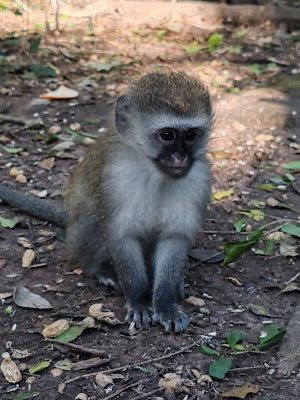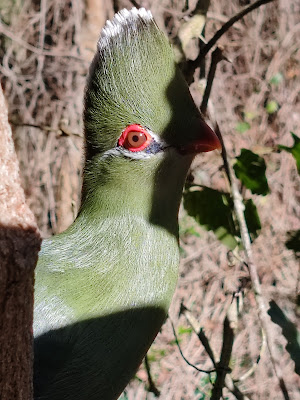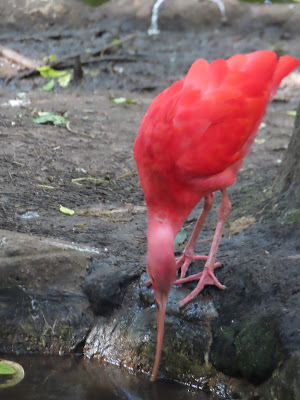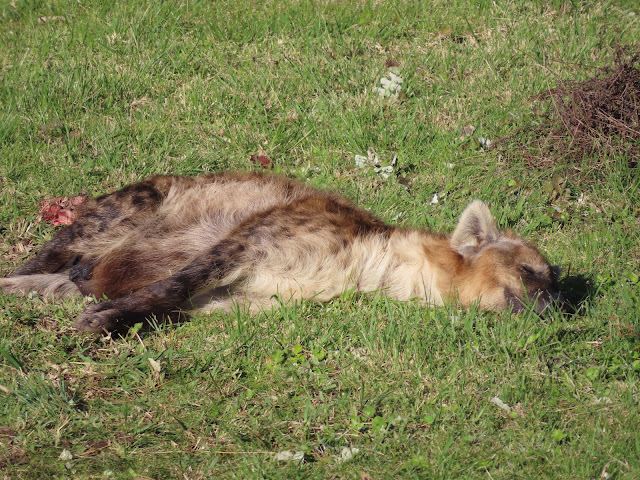We figured the mild temperatures of late Fall / early Winter in South Africa would provide the perfect weather to explore the Garden Route. Luck was with us too, because we arrived in George after a straight week of rainfall.The flight from Johannesburg was short (a little under two hours) and cost us about ZAR 6000 (approximately EUR 300), including one checked luggage each (with FlySafair). We rented a SUV with First Rental Car, a company we had previously used when we went to Cape Town. In spite of several sections of road work along the way, the drive from George to our first accommodation north of Plettenberg Bay (approx. 125 km or 80 miles) was extremely pleasant, with scenic views over the ocean, coastal towns and beaches to the right, and the striking mountain range to the left.
For our first stop, we chose to spend a couple of nights at the Trogon Treetop House and Forest Spa, (https://www.trogonhouse.co.za) located in The Crags, about 25 km past Plettenberg Bay. Nestled in the middle of the forest, with only a mile-long dirt path leading to its entrance, the property is ideally located next to Monkeyland and Birds of Eden, two parks not-to-be-missed.

It only has 5 rooms, two standard rooms next to the pool and the shared amenities, and 3 suites set apart with a boardwalk leading to them through the trees. We occupied suite number 4 (on our first night, we were the only guests) for just over ZAR 3000 per night, breakfast included (approx. EUR 150). Bear in mind that this is the low season. Our suite came with a spacious bedroom with a comfortable king-size bed, a balcony looking over the forest, and an en-suite bathroom. And the electric blankets made sure we spent a comfortable night. No shared wall with another suite, so absolute quietness, apart from a few forest noises, monkey hoots mostly.
The shared dining/lounge space and pool/terrace area were beautifully decorated with local African art and furniture, with breathtaking views over the forest and the valley.
The property also offered dinner for ZAR 325 per person, provided you give them a 24-hour notice. Because there were not many dining options in the vicinity, and the dirt road connecting the hotel to the main road is a bit treacherous in the dark, we decided to have dinner there both nights. It was not "grande cuisine" by any means, but a decent home-cooked three-course meal.
Th next morning, we were ready for a full-day adventure, first visiting Monkeyland and Birds of Eden, and then heading to the Tsitsikamma National Park (40 km east) to hike the Storms River trail. In order to secure our access in advance, we bought our tickets to Monkeyland and Birds of Eden online a couple of weeks prior to our departure (https://www.monkeyland.co.za/page/our-rates). An adult combo ticket for both parks is ZAR 610 (approximately EUR 31). Expect a 9% price increase in 2025 (the 2025 rates are already published). As it turns out, booking in advance was not necessary as this is the low season. We started our visit with Monkeyland, with an assigned guide to accompany us through the park (mandatory).


Ralph, our very knowledgeable guide, took us on a 30-40 minute walk through the forest, sharing with us details about the origin and customs of the ten species of monkeys we encountered, including lemurs, gibbons, capuchins, sakis and the indigenous vervet monkey (blue-balled). It was amazing to be surrounded by so many monkeys (the population in the park reaches 550 animals), following us around sometimes. What an incredible experience.
Oh, and did I mention the incredible suspended bridge, where monkeys sometimes run along the top cables and snatch something off your head, like your favorite hat or sunglasses (that didn't happen to us)?
After this amazing start of the day, we had no idea that we would be even more awestruck during our visit of the Birds of Eden park. Located just across the parking lot of Monkeyland, it is the world’s largest free-flight bird aviary (50 meters high, covering 23 000 square meters of forest). If the monkey park looked like a regular forest with tall trees and few shrubs, the valley housing the Birds of Eden felt like a rainforest, with tropical plants, hanging vines and waterfalls. The contrast of flora between the two parks was so unexpected.
But the real gems here are the hundreds of exotic and indigenous birds, waiting to be discovered along the walkways, suspended bridges and ponds. No guide provided here. You just follow the trail up and down the wooden walkways at your own leisurely pace, and marvel at the amazing species flying around, with the brightest colors of feathers.


Above: the Knysna Loerie (indigenous bird). The tips of his wings are red when it takes flight.
For ZAR 20 at the park's gift shop (EUR 1), you can buy a booklet to help you identify all the species (220+) currently living in the sanctuary.
The birds are so accustomed to humans that they're not afraid to approach you. That was particularly true with the flamingos and red ibis.
Around noon, we drove to the Storms River Mouth Restcamp (47 km from the Birds of Eden park). At the entrance of the Tsitsikamma National Park, we bought 2 tickets for a one-day access : ZAR 74 for South African citizens and residents. The price for one adult ticket goes up to ZAR 148 for SADC nationals (Angola, Botswana, Comoros, Democratic Republic of Congo, Eswatini,
Lesotho, Madagascar, Malawi, Mauritius, Mozambique, Namibia, Seychelles,
South Africa, Tanzania, Zambia and Zimbabwe) and ZAR 296 for international visitors. By 1pm, we were quite hungry and had a quick lunch : fish and chips for me (bit greasy but the fish was tasty) and fried shrimp and calamari. Come to think of it, this may not be the best choice of food before starting a hike...
The hiking trail starts from a small beach, a couple of hundred yards away from the outdoor terrace where we had lunch. For the aquatic sports lovers, there are kayaking tours available as well.
Supposedly short (1,3 km) and easy, the first part of the trail turned out to be a bit more arduous than we anticipated, with lots of stairs going up and down the hillsides along the coastline. However, the views were stunning and worth the effort. The second part of the trail (beyond the suspended bridges) climbs all the way up the top of the hill), but we didn't make it that far. We did run into a group of dassies on our way to the bridges.
The next day, on our way to our next destination, Plettenberg Bay, we stopped at the Mohair Millshop, an art and crafts indoor market located just one kilometer or so from the Monkeyland parking lot, heading towards the main road (
https://mohairmillshop.com/). Outside the warehouse, there was a pen with a handful of angora goats (whose hair produces the softest mohair wool). In addition to homemade mohair socks, sweaters, blankets and scarves, the store offered a wide array of ceramics, paintings and leather goods, produced locally.
Since we couldn't check in before 2pm at our next accommodation in Plettenberg Bay, we decided to visit the Jukani Sanctuary (another animal park owned by the operators of Monkeyland and Birds of Eden) focused on large feline mammals rescued from zoos or private owners. Like Monkeyland, Jukani is not a park where you are free to roam at your own leisurely pace. So once a guide had been assigned to us, we set out to stroll between the enclosures to watch tigers, lions, hyenas and pumas going about their lazy morning routine.
Detail of a Bengali tiger
In Plettenberg Bay, we booked a room at Barrington's (
https://www.barringtonsplett.co.za/) a boutique hotel (only 10 bedrooms) located on top of a brewery, surrounded by gardens used by the brewery's restaurant to grow its own herbs and vegetables. Our room (superior) came with a balcony overlooking the rugged hills of Plettenberg Bay across the road). We paid ZAR 2077.65 (approximately EUR 105) for one night (off-season), and that included breakfast as well as a chip for a free beer tasting at the brewery.
We headed to Central Beach for lunch, as one of Barrington's employees recommended we try a seafood restaurant called Moby's (
https://mobydicks.co.za/). We had initially planned to have dinner at The Fat Fish, but our reservation got cancelled a couple of weeks prior to our departure due to their closing for renovation. Moby's turned out to be a pleasant surprise, where we had a whole grilled fish and the most delicious mussel chowder I've ever tasted. We also booked 2 tickets for the next morning to see whales with Offshore Adventures (
https://offshoreadventures.co.za/) for ZAR 970.00 per adult (approx. EUR 48).
After a lazy afternoon exploring the shops on Main Street, we headed back to Barrington's to enjoy our beer tasting and relax a bit until dinner.
Since the Fat Fish was closed, we booked a table at the brewery's restaurant, where we absolutely recommend the pot stickers (or gyozas) as well as the smoked ribs (the smoker was right outside on the patio). We absolutely recommend eating there if you stay at Barrington's.
After breakfast the next day, we asked the concierge to store our luggage while we were going to see the whales, which they gladly did. At 10am, we boarded the boat, life jacket on, with 28 more passengers and headed out towards the Robberg Nature Reserve to observe the thousands of seals established there.
Then, our skipper took us further out in the bay, where two Southern Right Whales had been spotted.
One of them did break the surface a few times, but none breached unfortunately. Still it was quite a sight to behold (we plan on going to Hermanus in the future, which is arguably the best spot for whale watching in the Western Cape).


After retrieving our luggage from Barrington's, we hit the road again, for a quick 12 km ride to our next accommodation, Tsala Treetop Lodge (
https://tsala.hunterhotels.com/). Part of the Hunter Hotels Group, Tsala offers suites and villas amid the treetop, overlooking a stunning indigenous valley. Because it was off-season, we sent an email to the owners prior to booking in order to request a discount (most hotels and lodges offer discounts during the off-season here, just contact and ask them). We were offered a 30% discount and paid ZAR 8153.00 for one night (about EUR 400), breakfast included, down from the normal ZAR 12,000.00 rate. So, yes it was pricey, but was it worth it? Ab-So-Lute-Ly! Judge for yourself and watch the video below. Also, we had mentioned in the booking that we were celebrating our 25th anniversary, and we found the cutest note waiting for us on the coffee table of our villa, with a bottle of bubbly, and a tray of savory and sweet treats!

Entrance to the lobby
Our private pool (unfortunately, the water was too cold to enjoy)
The water in the pool was freezing (it was Winter after all), but the tub was too inviting to pass up. And since we had already booked a table for dinner at Zinzi (
https://zinzi.hunterhotels.com/) located 200 yards away from our villa, we decided to pamper ourselves and enjoy a lazy afternoon at the lodge.
A we crossed the small grassy field to the restaurant after sunset, we were surprised by a couple of roaming deer. At Zinzi, we opted for a few small plates to share instead of a traditional three-course dinner. Obviously, booking early wasn't necessary as there were only a couple of tables occupied besides ours (again, off season). Among other things, we had Chinese pork dumplings, tempura prawns on a bed of soba noodles, and a coconut & cardamom semifreddo. The food was absolutely delicious (only the fish curry was a bit disappointing, I had much better at the Oyster Box in uMhlanga Rocks).
When we got back to our villa, the staff had prepared the rooms for bedtime: the bathrobes were laid out in the bed, a fire was lit in the fireplace and there was a plate of chocolate covered strawberries waiting for us on the coffee table, with yet another sweet note.
After a restful night, we followed the boardwalk all the way to the lodge's reception building where breakfast is served in the restaurant. In addition to a fully stacked buffet with fresh fruits, juices, cold cuts, etc., we ordered eggs benedict from the menu. Upon checkout, we were each offered a small goodie bag for the road, containing a bottle of water and rusks (a South African staple made of twice-baked crunchy biscuits usually eaten dipped in coffee or tea).
Giant fern at Tsala Lodge
Back on the road again, we chose to make a pit stop in Knysna, on our way to George. Knysna is a beautiful town located around a spectacular bay, with an island in the middle (Thesen island) connected to the main land by a bridge. The island is mostly residential, with a few streets lined with shops and restaurants, and a marina where boat rides depart and canoes can be rented as well.
After a little bit of shopping and lunch on the water's edge, we resumed our road trip to our final accommodation on this trip: the Buff & Fellow Eco Cabins, on the outskirts of George (
https://www.buffandfellow.co.za/). For our last night before an early flight back to Johannesburg the next day, we booked a cottage made out of a recycled shipping container, sitting on the edge of a pond. The property belongs to a family of farmers, and upon self check-in, we drove through enclosures where Western Cape buffaloes, springboks, zebras and rhinos were roaming free.
We stayed in Eco Cabin 4, at a rate of ZAR 2371.84 (about EUR 115.00) for one night. The cottage itself was well laid out and equipped, with a grill and a wood-fire hot tub on the balcony, but it got freezing cold at night, and the little fire stove in the living-room (at one end of the container) was not enough to warm up the bedroom at the opposite end.
The owners of the property offer an extensive menu of pre-assorted boxes to purchase on their website prior to your arrival (with a minimum 24 hour notice), for you to grill (meat and sausages locally sourced at the farm) or bake (make your own pizza), and they also have a small honesty shop where you can buy some essentials. I strongly advise you order one of these boxes if you plan to stay there, as there are no dining options nearby. I had to drive 10 km to the nearest town of Groot Brakrivier to get a mediocre take away pizza from a local pub/restaurant.
After a cold night spent shivering, we got up early to have enough time to return our rental car and catch our flight back to Johannesburg. Unfortunately, two rhinos decided to block the only way out of the property (a narrow dirt road on the levee along the pond's edge). We had to wait 20 minutes for them to walk leisurely to our side of the pond, where they decided to split and pause a few meters from our car, one to the left, one to the right. We pondered what to do for a minute (we didn't want to return the rental car with a giant dent on both sides!), and then decided to hit the gas and squeeze between the beasts.
This was the nerve-wracking end to an amazing week along the Garden Route, a region of the Western Cape we are looking forward to visiting again. We hope our little review will help others plan their trip to this incredible part of South Africa.










































































Wow, what am incredible trip - steph
ReplyDeleteFor foreigners who are not familiar with the area, Expat Housing extra relocation assistance services like orientation tours or community networking opportunities could help the offer stand out.
ReplyDelete